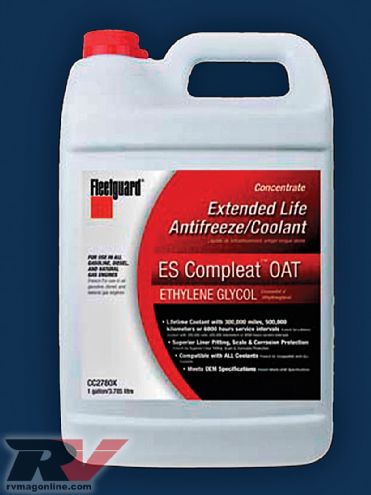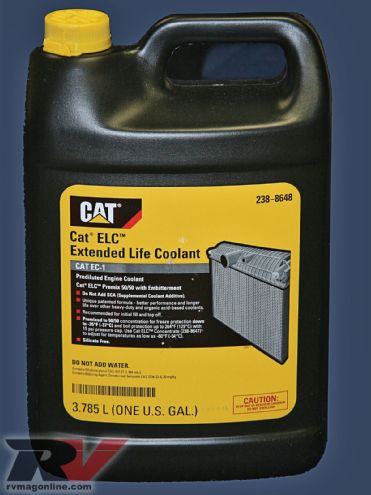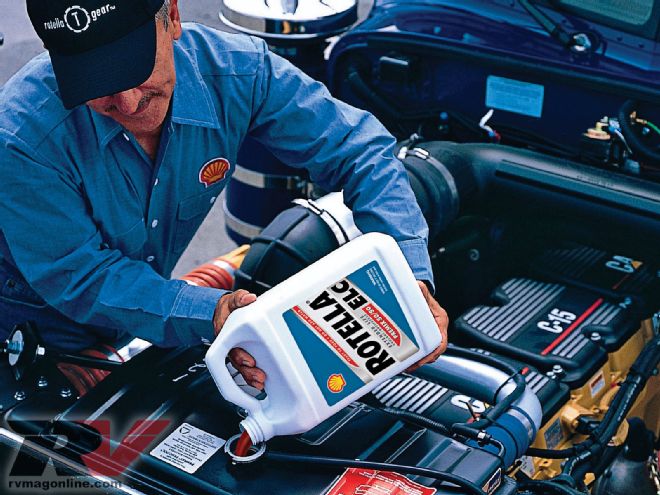Proper cooling is critical to any engine. Without some way to remove the heat created during the combustion process, the engine will quickly become a lump of scrap metal. But today's coolants provide many other functions: They prevent cracked engine blocks in freezing weather and add corrosion and scale inhibitors, water pump lubricants, and other additives essential to efficient operation of the engines. The original term "antifreeze" was gradually replaced by coolant, which really is a more accurate term.

| When climbing mountain grades, it's important to keep your cooling system in optimum condition to prevent overheating.
What They Do
Diesel engines place greater demands on coolants than a typical gasoline-powered engine. Diesel fuel has much more BTU per gallon than gasoline. This gives a diesel engine the potential to create more power and torque than an equivalent-size gasoline engine. Of course this extra energy also creates more heat, so the cooling system requirements of a diesel engine will also be greater.
Engine blocks used in automotive applications have cylinders that are bored into a one-piece casting. When they are worn out or damaged, the engine block will need to be scrapped. Heavy-duty engines that are used in trucks are designed to last for many miles, so they use replaceable cylinder liners that can be removed from the engine block and replaced when worn or damaged to minimize operational costs over the life of the vehicle. A motorhome typically does not rack up as many miles as a daily-driven truck, but the engine is still in the heavy-duty class so its construction will be similar.
Cylinder liners come in two designs: dry-sleeved and wet-sleeved. Dry sleeves are inserted into the engine block and surrounded by outer walls cast into the block that contact the coolant so the coolant never touches the actual cylinder liner. Wet sleeves are inserted into a block that does not have any outer cylinder wall. The coolant in the engine actually contacts the cylinder liner itself. The liner has flanges and counterbores on its outside diameter that are used to hold O-ring seals so that the coolant stays in the engine's water jackets and doesn't leak down into the engine's oil sump.

| Many diesel pushers utilize a rear radiator with a charge air cooler for the turbocharger stacked directly above it.
Typically, dry sleeves are used on smaller engines, while wet sleeves are used on larger engines. The reason for this is that larger engines create more heat, and the wet sleeve does a much better job of conducting that cylinder heat to the coolant because the wet sleeve is in direct contact with the coolant. Engines like the 5.9-liter Cummins ISB and 7.2-liter Cat C7 use a dry sleeve, while larger engines like the 8.3-liter Cummins ISC, 8.9-liter Cummins ISL, etc. all use wet sleeves. Dry sleeves aren't as picky with coolants, but wet sleeves do have unique requirements and coolant selection and maintenance are critical. This all has to do with cavitations and liner pitting.
Liner pitting is a result of something best described as "cavitation." Wet cylinder liners are held in place in the engine block with O-ring seals and the clamping pressure of the cylinder head upon the upper flange of the liner. As the piston moves up and down, there is also side-to-side force being exerted on the cylinder due to the throw of the crankshaft. This lateral force causes these liners to vibrate back and forth. When the cylinder moves in one direction, it moves away from the coolant, creating a small air bubble in its wake. Eventually this air bubble bursts and the coolant, which is under pressure, bursts through and impacts the cylinder liner. This sudden jet of high-pressure coolant can pit the liner, and if allowed to continue, will create a pinhole through it. In wet-sleeved diesel engines, this vibration and air bubble popping happens repeatedly whenever the engine is running. Eventually, these pits deepen and cause pinholes, which will allow coolant to pass into the combustion chamber. When this happens you'll find your coolant level going down, increased operating temperatures, and white smoke coming from your exhaust. By the time you see this it's too late, and you'll be in for some expensive engine overhaul costs.

| This cylinder liner has numerous pits and pinholes and has failed from the effects of cavitation.
Regular coolants just can't handle the effects of cavitation, so don't put Dexcool into your large wet-sleeved diesel. There are a number of heavy-duty coolants available for diesel engines, and each has its own specific formulations and specifications. Couple this with the fact that Cat and Freightliner have their own private-labeled coolants, and things get really confusing for the average RVer.
Combating Cavitation
To combat the effects of cavitation, some coolants use a borate and nitrite salt additive package to coat the surface of the liner. This coating reduces the surface tension of the coolant and also forms a protective coating on the liner. Other coolants may use a phosphate/molybdate-based inhibitor package, so it's important to use the correct product and never to intermix them.

| A refractometer is the best way to test coolant for proper freeze protection level.
These coatings are gradually eroded by the pinging caused by cavitation, but the additives continually replenish this coating so everything remains in balance. The problems begin when these additives begin to deplete themselves from the coolant.
Because the additives are continually trying to "plate" the surface of the liner, they will eventually run out. There are a number of circumstances that determine just how fast this will happen, but the most critical is the quality of the coolant and the water mixed with it. Regular tap water is full of minerals and stuff that you really don't need in your cooling system, so it's best to use distilled or de-ionized water when filling your system with coolant. If you can keep that stuff out from the beginning, your coolant will have a better chance at surviving longer. Using a pre-formulated coolant, which is already reduced with de-ionized water, is the easiest way to keep contaminants out.
A cooling system with good fresh coolant starts out with a high additive concentration. Eventually, scale and lime begins to form in the coolant, increasing the acidity of the coolant. The various metals in the engine react with your coolant to modify its mineral content and reduce its effectiveness. Add in the fact that your additives are depleting simply by the constant bonding action to the liner wall, and you can see why coolant has a given length of time to do its job. For that reason, it's important to test your cooling system to determine what the various levels of these additives are.
Pure antifreeze doesn't cool that well, and pure water freezes. An ideal coolant mix is 50 percent water and 50 percent coolant, which is what a pre-formulated mix will contain. That will give you adequate freeze protection as well as optimum cooling.
Do not add plain water or plain unmixed coolant to top off a cooling system that is low, or you will change that ratio and cooling ability will suffer and you'll run the risk of freeze-ups. Testing your coolant's freeze level will require a hydrometer or refractometer. These devices measure specific gravity so that you will know when your coolant has dropped below its freeze protection level and is no longer at that 50/50 ratio. A hydrometer operates by squeezing the bulb until the center unit floats. A hydrometer's reading then needs to be compensated for temperature in order to obtain an accurate reading. A refractometer is a better choice because even cold coolant can be accurately tested, plus you can also use it to test the specific gravity of your flooded battery electrolyte as well.
Using Test Strips
Neither of these will tell you the condition or chemical composition of your coolant. That is performed by using test strips. The test strips are litmus-based paper strips that you dip into your coolant. It will change colors according to the chemical makeup of your coolant. A color reference card is included and is then used to convert these readings into real numbers.

| Test strips are used to measure the SCA levels in your coolant to determine if any additional DCA additives are required.
If your additive levels are too low, you don't have to replace the coolant. All you really have to do is add some more additives. These additives are referred to as supplemental coolant additives, or SCA. The SCAs come in a quart jug, but be sure you know which can is required for your specific coolant. If your coolant uses a borate/nitrite-based inhibitor package you'll want to use the DCA2 style of additive, but if your coolant is phosphate/molybdate-based you'll need the DCA4 additives. First verify exactly which coolant is in your engine, then check with that coolant's spec sheet to determine which SCA additive product is designed to work with that coolant.
If you really aren't sure which coolant is in your RV, you may want to just consider dumping it out and starting over with something that you know and can easily obtain. Chances are it'll have to be dumped soon enough anyway. Even "long-life" coolant doesn't last forever.
Judging a coolant by its color isn't the easiest way anymore. The old green heavy-duty coolants were gradually replaced by pink coolants, such as Fleetcool, which had better additives to prevent liner pitting. Other manufacturers followed suit and colors were all over the board. Just a few years ago, Fleetguard, a division of Cummins, had a pink extended-life coolant, a green heavy-duty coolant, a blue ES Compleat coolant (that confusingly looked very much like windshield washer fluid), as well as an orange Optimax OAT coolant. You really need to know what's in your coach so you can monitor it with the proper test strips and use the correct additives. If in doubt, throw it out. Then start over and keep records. Remember, if you don't keep your SCA levels up or mix up the wrong stuff, you'll cause liner damage and that gets very expensive.
Older RVs
Some of the older RVs used coolant filters. If you have a filter, be sure that you are replacing it with the correct filter. Many of these are not filters at all. They look like filters, but in reality they are SCA dispensing agents designed to dispense SCAs over time to keep your SCA levels up so you don't have to add them from cans every now and then. Again, be sure to check these SCA levels with test strips every six months to be sure that the "filter" is still working. There are a number of popular coolants on the market.
Daimler, which owns Freightliner, markets the Alliance brand of coolant. Peak Antifreeze offers a number of coolants, including the Fleetcharge antifreeze so popular with heavy-duty diesels. Old World Industries offers the Final Charge extended-life coolant, which is also handled by Peak. The Fleetguard division of Cummins, known for its high-quality filters, makes a number of coolants as well, especially the new ES Compleat OAT extended-life coolant.
Latest-Generation Coolants
The latest generation of coolants is referred to as Extended Life Coolant (ELC) and is a significant improvement over coolant technology of just 10 years ago. The majority of these coolants use Organic Acid Technology (OAT) to eliminate the constant monitoring of SCA levels. In addition to this low-maintenance approach, they are longer lasting and a far better coolant.
The final benefit is that any of the OAT coolants are compatible with each other. OAT coolants do not use nitrite/borate salts or phosphate/molybdate additives as SCAs. Instead, they utilize carboxcylic/fatty acids to handle those needs. The largest benefit is that the coolant is good for 6 years or 600,000 miles-whichever comes first. The only maintenance requirement is that you must add a can of extender at 3 years or 300,000 miles to replenish the additives. You do not have to monitor SCA levels anymore because there are none, so throw away those test strips. You do not add any SCA additives to an OAT coolant either, so if you have converted to an OAT coolant and have an SCA filter, just remove it or replace it with a plain old filter without any additives.
But, OAT coolants have many other benefits as well. Organic acids are kind to aluminum. Traditional coolants tend to eat away at aluminum, and you'll find corrosion and deposits in water pump housings after awhile. Radiators, as well as their solder joints, are much better off with OAT coolants. Your generator set has lots of aluminum in its engine, and OAT coolants will keep that system much cleaner and efficient than a non-OAT coolant. Finally, the fatty acids are actually good for your water pump and help keep it lubricated, which is just the opposite of the traditional coolants that rely on short-term additives in the coolant to accomplish this. That's why it's not a really good idea to "extend" an extended-life coolant because the additives do drop off as the coolant ages with use. OAT coolants don't have that issue and just need a quick shot of extender at three years to keep your RV's cooling system up to snuff

| Motorhomes with larger diesel engines generally have side-mounted radiators. Testing or adding coolant is accomplished through the rear access doors to access the coolant surge tank.
OAT coolants are compatible with just about anything, so you can use the same stuff for your engine as well as your generator. They are also cross-brand compatible. Peak's Final Charge coolant is an organic acid coolant and is currently used by Spartan in its chassis. Cummins' Fleetguard Division originally made an OAT coolant called Optimax, but this has now been rebranded as ES Compleat OAT extended-life coolant. Caterpillar offers its own Cat ELC coolant, which also uses hybrid OAT technology. All three of these are 100-percent compatible, so if you can't find one brand you can go into any truck dealership and pick up one of the others at the parts counter. The majority of the OAT coolants are orange in color, although this can vary, so color alone won't determine OAT status. Shell's Rotella ELC coolant is more of a red in color. It too is an extended-life coolant that can go 600,000 miles; however, it is not a true OAT coolant, so don't go mixing this with any of the other brands of OAT coolants.

| Coaches with larger diesel engines require greater cooling capacity. Side radiators are typically used with either a belt-driven or hydraulic fan motor.
Diesel coolants have come a long way in recent years. Even if you don't have wet-sleeved cylinders, you can still benefit from engine-friendly OAT coolants and the extended service intervals of any ELC coolant. Your engine will thank you for it.


